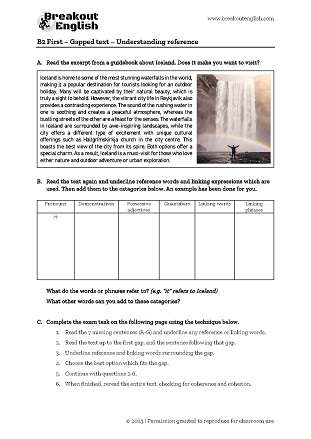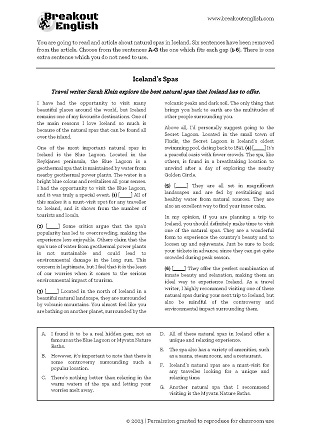The gapped text task from Cambridge First (FCE) Reading part 6 can be tricky. I’ve always found students can swing from getting a full 12 points (2 points per question) or only getting 2 or 4 points. There doesn’t seem to be much middle ground because once you get one gap wrong, you’re likely to get another one wrong too.
Are you preparing for the Cambridge First (FCE) exam and feeling a bit intimidated by the Reading Part 6 gapped text task? Read on for some tips and tricks and a free downloadable worksheet to analyse the task. This task can seem quite challenging at first, but with a little strategy and practice, you can master it. We’ll focus on reference words and linking expressions to show how the task focuses on coherence and cohesion. The topic of the task is travel, specifically Iceland, one of the world’s unique tourist destinations.

Contents
What is B2 First (FCE) Reading Part 6 Gapped Text?
The gapped text task requires you to reconstruct a long text by filling in the gaps with the correct sentences. You have a long text with 6 sentences removed. Just to add to the fun, Cambridge adds an extra sentence that doesn’t fit in any gap. The task is to put the sentences in the correct order to form a coherent and cohesive text. This task is designed to test your ability to understand the flow of information and how different sentences relate to each other.
FCE Reading Part 6 can seem daunting, but with a little strategy and practice, you can master it. Remember to focus on reference words and linking expressions, analyse the context, use the information provided, maintain coherence and cohesion, avoid overthinking, and pay attention to the extra sentence. Always take a moment to read through the task quickly one more time before finishing. If it doesn’t sound right when you read it through, go back and check your answers!
First (FCE) reading tips
Identify reference words and linking expressions. Reference words, such as pronouns and nouns, help to link the sentences and provide context. Similarly, linking expressions, such as conjunctions, can provide clues about the relationships between sentences. By paying close attention to these words and expressions, you can better understand the structure of the text and make informed decisions about where to place the sentences. As you are reading through the text, underline all of these words. When you go back to look again later, it will help to have them underlined.
Reference words and linking expressions commonly seen in Reading part 6 are:
- Pronouns: he, she, it, they, him, her, etc.
- Demonstratives: this, that, these, those
- Possessive adjectives: my, his, her, its, etc.
- Quantifiers: some, any, many, a few, etc.
- Linking words: however, therefore, consequently, etc.
- Linking phrases: as a result, in addition, on the other hand, etc.
Analyse the context. The context of the text is essential for determining the correct order of the sentences. You should consider the meaning of the sentences, the topic being discussed, and the overall flow of information in the text. By analysing the context, you can make informed decisions about which sentence should come first, second, and so on. Sometimes this comes down to what feels right, but educated guesses are still educated!
Use the information in the text and sentences provided. The text and sentences provided are your main tools for completing the task. You should read the text carefully and take note of any important information that can help you fill in the gaps. Additionally, you should examine the sentences provided and consider how they fit into the text. In fact, I normally recommend starting by reading the 7 sentences, and underlining any reference there, before starting the long text.
Maintain coherence and cohesion. The goal of the task is to create a text that is both coherent and cohesive. Coherence refers to the logical flow of information, while cohesion refers to the relationships between sentences. You should always keep these two concepts in mind while filling in the gaps.
Avoid overthinking or overcomplicating the task. The FCE Reading Part 6 gapped text task is designed to be challenging, but it’s important not to overthink or overcomplicate it. Instead, look for the most straightforward and logical solution. Remember, the goal is to create a text that makes sense after all is said and done.
Pay attention to the extra sentence. The extra sentence is added to throw off the test-taker, so it’s important to pay close attention to it. This sentence does not fit into any gap, and its purpose is to distract you from the task at hand. Double.check that your chosen sentence uses accurate reference and fits logically. Sometimes a single word can make the difference.

Materials
The accompanying worksheet provides an opportunity to look into the world of natural spas in Iceland and practise your skills in reconstructing gapped texts. Start with a discussion about unique tourist destinations and why people would choose to visit a place like Iceland’s over more traditional holiday destinations.
It’s always a good idea to follow up a task like this with some extra practice from an authentic exam, either in class or as homework.
EXAM PART: FCE Reading Part 6 – Gapped Text
EXAM SKILLS: Understanding reference
TIME: 30-45 minutes
PREPARATION: One copy of the worksheet per student
Procedure
- Introduce the topic by asking students what the most unique place is they have been on holiday.
- Tell the students that you are going to read about Iceland and if anyone know anything about it. Make a list of things to see in Iceland.
- Work as a class with the students to highlight reference words in the sample paragraph. Discuss reference, coherence and cohesion.
- Students work together to complete the rest of the task.
- Follow up with a discussion about sustainable tourism, which is briefly mentioned in the text.
Download





